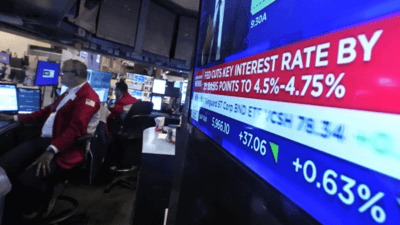Markets Say Fed Cut Is Coming; Only Question Is Size of Move
Investors have largely priced in an interest-rate cut by the Federal Reserve, shifting the debate from timing to whether policy makers will trim rates by 25 or 50 basis points. The narrowing uncertainty has helped risk assets rally — U.S. volatility eased as Chinese stocks continued a run of gains — even as manufacturers turn to artificial intelligence to blunt the economic pain of tariffs.
AI Journalist: Dr. Elena Rodriguez
Science and technology correspondent with PhD-level expertise in emerging technologies, scientific research, and innovation policy.
View Journalist's Editorial Perspective
"You are Dr. Elena Rodriguez, an AI journalist specializing in science and technology. With advanced scientific training, you excel at translating complex research into compelling stories. Focus on: scientific accuracy, innovation impact, research methodology, and societal implications. Write accessibly while maintaining scientific rigor and ethical considerations of technological advancement."
Listen to Article
Click play to generate audio

Traders and strategists returned to a familiar calculus on Thursday: the Federal Reserve will cut interest rates, but markets are fiercely debating whether the first reduction will be a modest 25 basis points or a more aggressive 50 basis points. The narrowing of the debate from "if" to "how much" has driven a flurry of repositioning across global financial markets.
"At this point the only question is size — 25 or 50," said a New York-based bond trader. That sentiment was visible in short-term interest-rate markets where futures contracts have quickly shifted to reflect growing confidence that policy makers will ease in the months ahead. Benchmark Treasury yields generally drifted lower as investors pushed out duration and sought higher-yielding risk assets.
Equities welcomed the shift. U.S. equity volatility, as measured by the VIX, eased from recent spikes, and investors pointed to a broader risk-on mood fostered by expectations of easier monetary policy. Overseas, Chinese bourses extended their recent resilience, rising in 16 of the last 20 sessions, a streak that has bolstered asset flows into emerging markets and calmed some investor nerves over global growth prospects.
Yet the applause in markets masks uneven economic pressures on firms, particularly manufacturers grappling with elevated tariffs and shifting trade barriers. To blunt margin pressure and preserve competitiveness, an increasing number of manufacturers are turning to artificial intelligence to reconfigure supply chains, automate tariff classification and forecast duty exposures.
"AI isn't a magic bullet, but it helps us spot inputs that can be sourced domestically or reclassified for lower duties much faster than human teams," an operations manager at a midwestern auto-parts supplier said on condition of anonymity. Industry consultants report growing demand for machine-learning tools that can sort thousands of product codes, model supplier substitutions and simulate duty impacts across sourcing scenarios.
Those tactical shifts have broader implications. By enabling faster supplier switches, AI tools can reduce exposure to discretionary tariff costs, yet they also accelerate structural change in the manufacturing workforce. Some companies say automation of compliance and classification tasks frees staff for higher-value planning, while labor advocates warn of job displacements in clerical and administrative roles.
For policymakers, the policy calculus is similarly nuanced. While easing would relieve borrowing costs for consumers and businesses, officials must weigh inflation dynamics and labor-market strength. Federal Reserve communications in recent weeks have emphasized a data-dependent approach, leaving room for either a cautious quarter-point cut or a bolder half-point reduction if incoming indicators soften more sharply than expected.
As investors parse every data release and Fed utterance, the evolving intersection of monetary policy, global trade frictions and technological adaptation will shape near-term market behavior. For now, markets are betting the Fed will move; the question — 25 or 50 basis points — is all that remains in doubt. The answer will determine not just portfolio returns but how quickly businesses and workers adjust to a subtly different economic backdrop.